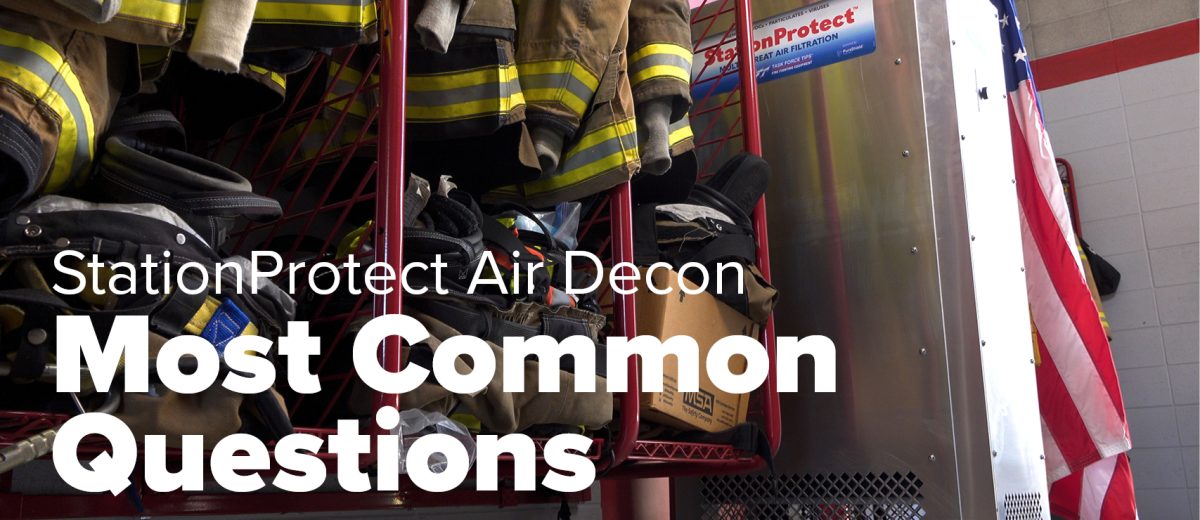12 Most Common Station Protect Questions
Are you looking for a way to decontaminate the air in your station and reduce the number of volatile organic compounds (VOCs), particulates, and aerosols that put your crew at risk? Have you been searching out how to deal with off-gassing and exhaust fumes that can cause cancer and other diseases? You know these are major risks for your crew and you need a solution that can address the three major air contamination concerns facing firefighters without taking a lot of time from you or your crew.
In this article we will go over some of the most frequent questions we receive about the StationProtect Air Decontamination and Filtration System.
Let’s dive into some of the most frequent questions we receive about StationProtect.
StationProtect FAQs
Where is the best place to install StationProtect in my station?
You should place your StationProtect as close as possible to the hot zone/ warm zone area of your station. The hot zone is your designated area for everything contaminated that needs to be decontaminated, while the warm zone is commonly the apparatus bay. Placing the StationProtect here allows it to reduce the VOCs and particulates in the air from off-gassing gear and exhaust systems.
If you have a station with living quarters, you may also choose to place one in or near this area to offer further protection.
I want to put it next to our bunker gear rack in the bay. Will the opening and closing of the bay doors affect the efficiency of the StationProtect?
The disruption of the air when the bay doors open and close will aid the StationProtect in capturing the particulates, soot, VOCs, and mold. The air movement from your bay doors is beneficial!
How large of a space can the StationProtect clean?
Each unit cleans the air in spaces up to 2400 square feet. The airflow is adjustable up to 655 cubic feet per minute.
Do I need just one unit for my whole station?
The number of StationProtect systems you need depends on the size of your station. Each unit can effectively clean spaces up to 2400 square feet. So, if your station is 2400 square feet or smaller, only one unit is needed. If it is larger, you will need an added unit for the best results.
Some departments choose to install one unit near their bunker gear and another unit near the sleeping quarters or kitchen area to enhance the air quality of the station further.
Are there special electrical requirements needed for running the StationProtect?
No, there are no special electrical requirements needed for the StationProtect. The unit uses a single phase 110v or 220v wall outlet, depending on the model you buy. We recommend placing the unit on a surge protector to protect the unit from unexpected power fluctuations.
Can StationProtect be moved easily?
The StationProtect unit is extremely easy to move! Each unit comes on caster wheels and simply plugs into a wall outlet. This means you can move the unit for cleaning purposes, cartridge changes, or because you decided it would work better in another location.
What if my crew shuts it off?
Your StationProtect unit offers the most comprehensive protection when it is allowed to run continuously. The system can only clean the air while it is running. We recommend discussing the unit and its purpose with your crew so that they understand what the unit does and how it helps them.
How often do I need to change the cartridge?
Since the unit is made with you and your busy schedule in mind, upkeep is easy! The four-stage cartridge system as a whole needs to be changed once per year. One piece of this cartridge, the prefilter, gets changed every three months. When you buy your replacement cartridge kit, it comes with everything you need for the entire year, including the four prefilters that will need changed.
Want to see what the cartridge change looks like in action? Watch the video here:

Does StationProtect capture mold?
Yes! The StationProtect cartridge is designed to capture mold. Once captured, the mold and other contaminants are encapsulated and neutralized, meaning they are no longer a threat to you or your crew!
Is the StationProtect unit durable?
The unit is made from steel with an aluminum outer surface shell. This makes it durable and easy to clean!
How loud is StationProtect?
At the maximum setting, the unit is just 60 decibels making it comparable to a standard business office environment. For comparison, the average household refrigerator runs at about 55 decibels and a vacuum cleaner around 75 decibels. You can also control the unit with a speed control knob that lowers the noise level/protection setting as needed.

